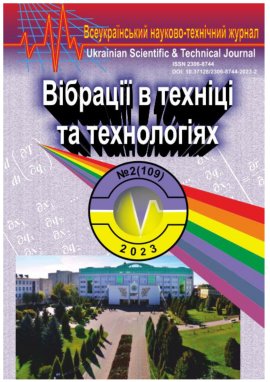
Issue №: 2(109)
The journal deals with the problems of vibration technologies and machines, mathematical methods of vibration process studies, information on design and technological development, presents teaching and methodological aspects of teaching in the Higher School of Applied Sciences, where vibration machines and technologies are studied.
MODELING THE STRUCTURE EVOLUTION DURING HOT ROLLING OF ALUMINUM ALLOYS USING THE DEFORM SOFTWARE
Chmykh Kateryna – postgraduate of Vinnytsia National Agrarian University (3 Sonyachna St., Vinnytsia, 21008, Ukraine, e-mail: catherina099@gmail.com, https://orcid.org/0000-0001-8873-4436).
Volkovskiy Igor – аssistant at the Department of Agroengineering and Technical Service, Vinnytsia National Agrarian University (VNAU), 3 Sontsivna Street, Vinnytsia, Ukraine, 21008.
The investigation of the structural evolution of aluminum alloys during hot rolling is a pertinent challenge in modern metallurgy. This study involves the modeling of the process of aluminum alloy structure formation during hot rolling using the DEFORM-3D software suite. The software allows for the replication of real rolling conditions and the prediction of changes in alloy structures.
The article presents modeling of evolutionary structures during the hot rolling of aluminum alloy 5182 BT (Al-Mg 4.5%) in a five-stand continuous hot rolling mill. The DEFORM-3D software product was used for mathematical modeling, and the Johnson-Mehl-Avrami-Kolmogorov equation was employed to account for recrystallization kinetics.
The results of calculations yielded the volume of recrystallized grains and their sizes throughout the entire rolling process. However, it is crucial to note that changes in grain sizes during the rolling of aluminum alloys are a complex process and do not follow a constant pattern. This is due to the influence of numerous factors related to both the metal's internal structure and the specific technological processes. Therefore, the modeling results require further verification through industrial experiments.
In this context, data regarding the evolution of texture and structure obtained during forced hot rolling "2800" with subsequent thread cooling of the metal were used for comparison.
In conclusion, this article contributes to a deeper understanding of processes occurring during the hot rolling of aluminum alloys and provides valuable insights into the impact of recrystallization on the final structure and material properties.
1. Shvets, L. (2020). The essence and possibility of the method of isothermal deformation. Slovak International Scientific Journal, 1(42), 16-24. [USA]
2. Aftandilants, Y.G., Zazymko, O.V., & Pokhilenko, G.M. (2020). Tekhnolohiya obrobky metaliv i splaviv tyskom: Navchalnyi posibnyk. Vydavnychyi tsentr NAU. [Ukraine]
3. Budyak, R.V., Posvyatenko, E.K., Shvets, L.V., & Zhuchenko, G.A. (2020). Konstruktsiyni materialy i tekhnolohiyi: Navchalnyi posibnyk. Vinnytsia National Agrarian University. [Ukraine]
4. Popovych, V. (2000). Tekhnolohiya konstruktsiynykh materialiv i materialoznavstvo. Knyha I. [Ukraine]
5. Shuts, A.A., & Matviichuk, V.A. (2016). Kompiuternе modeliuvannia protsesu shtampuvannia obkochuvanniam trubnykh zahotovok. Tekhnichni nauky: Zbirnyk naukovykh prats, 1(95), 178-184. [Ukraine]
6. Raghunathan, N., & Sheppard, T. (1989). Microstructural development during annealing of hot rolled Al–Mg alloys. Materials Science and Technology, 5(6), 542-547. [USA]
7. Wells, M.A., Maijer, D.M., Jupp, S., Lockhart, G., & van der Winden, M.R. (2003). Mathematical model of deformation and microstructural evolution during hot rolling of aluminium alloy 5083. Materials Science and Technology, 19(4), 467-476. [USA]
8. Shvets, L. (2020). Extension value, with hot rolled aluminum alloy specimens, round section in smooth rollers. In Scientific Foundations of Modern Engineering (pp. 234-240). Boston (USA). [USA]
9. YI You-ping, FU Xin, CUI Jin-dong, & CHEN Hua. (2008). Prediction of grain size for large-sized aluminium alloy 7050 forging during hot forming. Journal of Central South University of Technology, 15(1), 1–5. [USA]
10. Zhang, H., Peng, D.S., Yang, L.B., & Meng, L.P. (2001). Recrystallization model for hot-rolling of 5182 aluminum alloy. Transactions of Nonferrous Metals Society of China (English Edition), 11(3), 382-386. [USA]
11. Shvets, L. (2021). Restoration of body parts. Colloquium-Journal, Poland, 8(95), 44-53. DOI: 10.24412/2520-6990-2021-895-44-53. [English]
About journal
The journal "Vibrations in engineering and technology" presents materials on the following issues
• Theory of processes and machines
• Mechanical Engineering and materialprocessing
• Processing and food production
The journal "Vibrations in Engineering and Technologies" is included in the list of technical scientific publications of Ukraine
(Category "B", Order of the Ministry of Education and Science of Ukraine dated July 2, 2020 No. 886)
Old version of the site: http://vibrojournal.vsau.edu.ua/
The journal "Vibrations in Engineering and Technology" is indexed by the following databases and catalogs:
The certificateof massmedia State registration:kv no 16643-5115 from 30.04.2010 .
Founder of the journal: Vinnytsia National Agrarian University
Kind of publication: journal
Type of publication : Scientific
Publication status: Domestic
Year of founding:
Periodicity: 4 times a year
Extent: 18.75 nominal printed pages
ISSN: 2306-8744 (printed version), (online)
Language of edition : (mixed languages) Ukrainian, English
The scope of the distribution and the category of readers: national, foreign, teaching staff, scientists, businessmen.
Periodical is included in the list of scientific professional editions of Ukraine approved by the Order of Ministry of Education and Sciences of Ukraine from 21.12.2015 No. 1328.
The journal "Vibrations in engineering and technology" is included in the "Catalogue of periodicals of Ukraine".
Journal subscription can be executed in each post office department.
Subscription Index is 99720.
Old version of site: http://vibrojournal.vsau.edu.ua/
In June 1994 the 2nd International Scientific and Technical Conference "Application of vibrations for technological purposes" was organized on the basis of Vinnytsia State Agricultural Institute. Leading experts in this field, noting the significant contribution to the school of Vibration Engineering under the leadership of P. S. Bernyk, proposed to create a professional all-Ukrainian scientific and technical journal "Vibration in engineering and technology..The journal was foundedat Vinnytsia State Agricultural Institute and P.S. Bernyk was elected to be the chief editor .
For all these years (since 1994) theJournal "vibration in engineering and technology" published 94 issues wherestudy of vibration effects, the creation of progressive energy saving technologies and equipment for their implementation were highlighted.
Currently Kaletnik H.M PhD , professor, academician NAAS is the chief editor of the "Vibrations in engineering and Technology"
The journal "Vibration in Engineering and technology", which has no analogues on the territory of Ukraine, is well known abroad.






